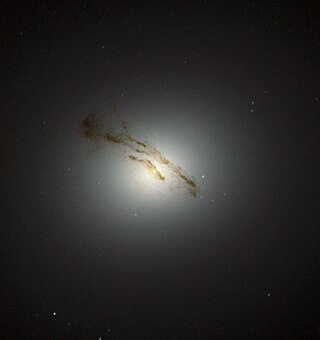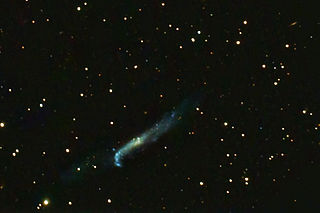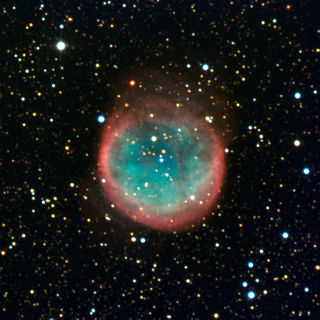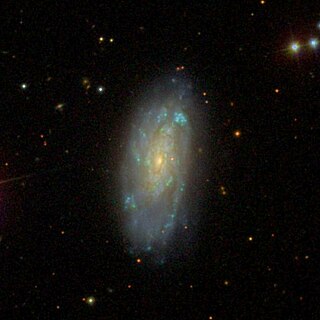
Messier 84 or M84, also known as NGC 4374, is a giant elliptical or lenticular galaxy in the constellation Virgo. Charles Messier discovered the object in 1781 in a systematic search for "nebulous objects" in the night sky. It is the 84th object in the Messier Catalogue and in the heavily populated core of the Virgo Cluster of galaxies, part of the local supercluster.

Messier 99 or M99, also known as NGC 4254 or St. Catherine's Wheel, is a grand design spiral galaxy in the northern constellation Coma Berenices approximately 15,000,000 parsecs from the Milky Way. It was discovered by Pierre Méchain on 17 March 1781. The discovery was then reported to Charles Messier, who included the object in the Messier Catalogue of comet-like objects. It was one of the first galaxies in which a spiral pattern was seen. This pattern was first identified by Lord Rosse in the spring of 1846.

NGC 3184, the Little Pinwheel Galaxy, is a spiral galaxy approximately 40 million light-years away in the constellation Ursa Major. Its name comes from its resemblance to the Pinwheel Galaxy. It was discovered on 18 March 1787 by German-British astronomer William Herschel. It has two HII regions named NGC 3180 and NGC 3181.

NGC 4656/57 is a highly warped edge-on barred spiral galaxy located in the local universe 30 million light years away from Earth in the constellation Canes Venatici. This galaxy is sometimes called the Hockey Stick Galaxy or the Crowbar Galaxy. Its unusual shape is thought to be due to an interaction between NGC 4656, NGC 4631, and NGC 4627. The galaxy is a member of the NGC 4631 Group.

NGC 6781, also known as the Snowglobe Nebula, is a planetary nebula located in the equatorial constellation of Aquila, about 2.5° east-northeast of the 5th magnitude star 19 Aquilae. It was discovered July 30, 1788 by the Anglo-German astronomer William Herschel. The nebula lies at a distance of 1,500 ly from the Sun. It has a visual magnitude of 11.4 and spans an angular size of 1.9 × 1.8 arcminutes.

NGC 2859 is a barred lenticular galaxy located some 83 million light years away in the constellation Leo Minor. The morphological classification is (R)SB(r)0+, where the S0+ notation indicates a well-defined physical structure that is lacking in visible spiral arms. It has a strong bar (B) of the "ansae" type, which means it grows brighter or wider toward the tips. A faint, secondary bar is positioned at nearly a right angle to the main bar. These features are surrounded by a weak inner ring (r) that appears diffuse. The outer region of the galaxy hosts a prominent, detached ring (R) that includes a series of blue-hued knots along the eastern side.

A polar-ring galaxy is a type of galaxy with an outer ring of gas and stars that rotates over the poles of the galaxy. These polar rings are thought to form when two galaxies gravitationally interact with each other. One possibility is that a material is tidally stripped from a passing galaxy to produce the polar ring. The other possibility is that a smaller galaxy collides orthogonally with the plane of rotation of the larger galaxy, with the smaller galaxy effectively forming the polar-ring structure.

NGC 5466 is a class XII globular cluster in the constellation Boötes. Located 51,800 light years from Earth and 52,800 light years from the Galactic Center, it was discovered by William Herschel on May 17, 1784, as H VI.9. This globular cluster is unusual insofar as it contains a certain blue horizontal branch of stars, as well as being unusually metal poor like ordinary globular clusters. It is thought to be the source of a stellar stream discovered in 2006, called the 45 Degree Tidal Stream. This star stream is an approximately 1.4° wide star lane extending from Boötes to Ursa Major.

NGC 2867 is an elliptical Type II planetary nebula in the southern constellation of Carina, just over a degree to the NNW of the star Iota Carinae. It was discovered by John Herschel on April 1, 1834. Herschel initially thought he might have found a new planet, but on the following night he checked again and discovered it had not moved. The nebula is located at a distance of 7,270 light-years from the Sun.

NGC 6522 is a globular cluster of stars in the southern constellation of Sagittarius. It was discovered by German-British astronomer William Herschel on June 24, 1784. The cluster has an apparent visual magnitude of 8.3 and an angular diameter of 9.4′. It is located at a distance of 25.1 kly (7.7 kpc) from the Sun, and lies in the Milky Way's central bulge, about 2.0 kly (0.6 kpc) from the Galactic Center. The cluster is centered in a region of the sky known as Baade's Window. It is highly impacted by reddening due to interstellar dust and the view is heavily contaminated by field stars, making it more difficult identify members.

NGC 157 is an intermediate spiral galaxy in the constellation of Cetus, positioned about 4° east of the star Iota Ceti. This galaxy can be viewed from suburban skies using a moderate-sized telescope. It was discovered on December 13, 1783 by William Herschel. The compiler of the New General Catalogue, John Louis Emil Dreyer noted that NGC 157 was "pretty bright, large, extended, between 2 considerably bright stars". It is a relatively isolated galaxy; the nearest other galaxy of comparable luminosity lies at a separation of 4.2 Mly (1.3 Mpc).

NGC 297 is an elliptical galaxy in the constellation Cetus. It was discovered on September 27, 1864, by Albert Marth and is classified as type E3, based on galaxy morphological classification.

NGC 298 is a spiral galaxy in the constellation Cetus. It was discovered on September 27, 1864, by Albert Marth. NGC 298 is situated close to the celestial equator and, as such, it is at least partly visible from both hemispheres in certain times of the year. Given its B magnitude of 14.7, NGC 298 is visible with the help of a telescope having an aperture of 20 inches or more.

NGC 327 is a spiral galaxy in the constellation Cetus. It was discovered on September 27, 1864 by Albert Marth. It is described by Dreyer as "faint, small, extended." It is nearby galaxies NGC 329, NGC 325 and NGC 321.

NGC 4274 is a barred spiral galaxy located in the constellation Coma Berenices. It is located at a distance of circa 45 million light years from Earth, which, given its apparent dimensions, means that NGC 4274 is about 95,000 light years across. It was discovered by William Herschel in 1785.

NGC 4494 is an elliptical galaxy located in the constellation Coma Berenices. It is located at a distance of circa 45 million light years from Earth, which, given its apparent dimensions, means that NGC 4494 is about 60,000 light years across. It was discovered by William Herschel in 1785.

NGC 4473 is an elliptical galaxy located about 50 million light-years away in the constellation of Coma Berenices. It was discovered by astronomer William Herschel on April 8, 1784. NGC 4473 has an inclination of about 71°. NGC 4473 is a member of a chain of galaxies called Markarian's Chain which is part of the larger Virgo Cluster of galaxies.

NGC 4242 is a spiral galaxy in the northern constellation of Canes Venatici. The galaxy is about 18 million light years away. It was discovered on 10 April 1788 by William Herschel, and it was described as "very faint, considerably large, irregular, round, very gradually brighter in the middle, resolvable" by John Louis Emil Dreyer, the compiler of the New General Catalogue.

NGC 2835 is an intermediate spiral galaxy located in the constellation Hydra. It is located at a distance of circa 35 million light years from Earth, which, given its apparent dimensions, means that NGC 2835 is about 65,000 light years across. It was discovered by Wilhelm Tempel on April 13, 1884. NGC 2835 is located only 18.5 degrees from the galactic plane.

NGC 7448 is a spiral galaxy located in the constellation Pegasus. It is located at a distance of circa 80 million light years from Earth, which, given its apparent dimensions, means that NGC 7448 is about 60,000 light years across. It was discovered by William Herschel on October 16, 1784. It is included in the Atlas of Peculiar Galaxies in the category galaxies with detached segments.




















